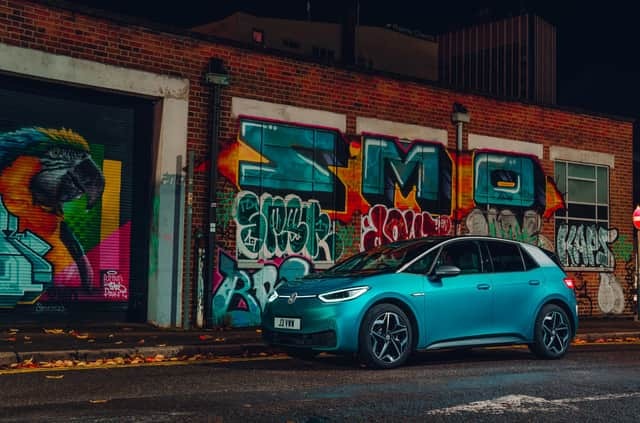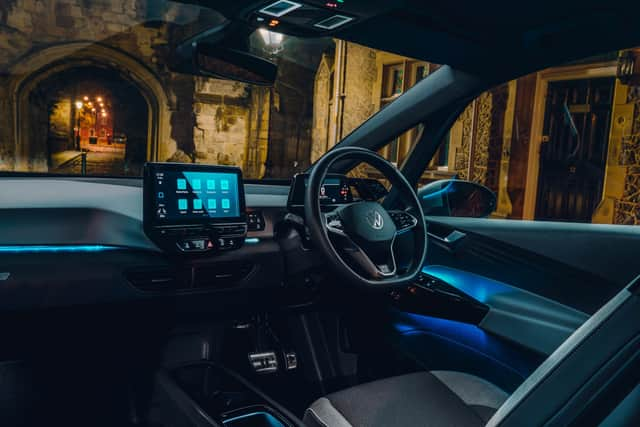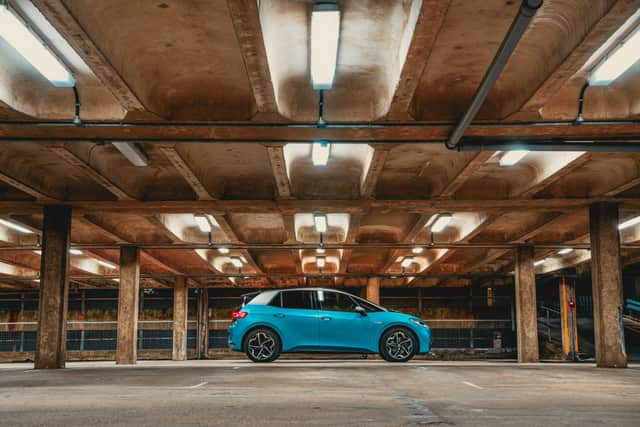Volkswagen ID.3 review: next generation family hatchback with practicality and performance on its side


Volkswagen isn’t messing about with its message around the ID.3.
The German marque might have other EVs on sale and plans for 10 more before the end of 2026 but the ID.3 was its first electric car and is apparently the start of the third major chapter in the brand’s history.
Advertisement
Hide AdAdvertisement
Hide AdThis is the car, in VW’s eyes, that’s going to succeed the Beetle and Golf as the default choice for a family hatchback. Das Auto for das 21st century.
“Bringing e-mobility to the masses” is how VW has ambitiously phrased it but, of course, virtually every other car manufacturer is trying to do the same. So the ID.3 has its work cut out to stand out among rivals as diverse as the Citroen e-C4, Nissan Leaf, Cupra Born, MG4 and Tesla Model 3.
While some brands are focusing their EV efforts on the big-money SUV segment, the ID.3 is proudly a proper five-door hatchback. Roughly the same size as a Golf, Focus or Astra, it’s gone for a look that blends in with those ICE models, rather than the more out-there styling of some EV rivals. There’s a recognisable VW-ness to the grilleless front end and a simple uncluttered profile only really broken up by the large contrasting tailgate panel. A polite observer would call it understated, a cruel one, unadventurous.
Although its footprint is similar to the Golf’s, the ID.3’s MEB platform means the wheelbase is much longer and, subsequently, there’s more room inside. The cabin feels fairly narrow and you wouldn’t want to be stuck in the middle of the rear bench for long but otherwise there’s an impressive amount of space. A family of four will have no trouble getting comfortable and even four adults will feel well catered for. The flat floor, low centre console and large areas of glass help enhance the feeling of space, while a 385-litre boot manages to marginally beat the Golf.
Advertisement
Hide AdAdvertisement
Hide AdWhile the exterior design is fairly unremarkable, the interior is more worthy of note. VW has gone for an absolutely pared-back approach with virtually no physical controls. The dashboard is a plain affair with two pods perched atop it - one small instrument binnacle and a 10-inch touchscreen that controls almost every function. Even the drive selector is mounted on the side of the instrument pod to keep the surfaces clear. It means the car feels airy and there’s a pleasing simplicity to it but at the expense of user-friendliness.
After much criticism, VW has already confirmed some updates for 2023, including a welcome return to physical buttons on the steering wheel rather than the rotten haptic touch ones on our test car. There are also updates coming for the infotainment system but it looks like we’re stuck with the hopeless “sliders” used for adjusting temperature and volume, which are an abject failure in design.


The interior also has quality issues. Some touch points have the usual solid VW feel but others, such as the door tops and dashboard plastics feel thin and brittle and far removed from the premium finish for which the Golf became famous.
Shortly after the ID.3 launched there was a dizzying array of motors and trims to choose from but right now, due to demand and continued component shortages you can only buy one version of the ID.3 - the Life trim with Pro Performance pack.
Advertisement
Hide AdAdvertisement
Hide AdThat means a single 201bhp motor driving the rear wheels and a 58kWh battery that’s good for 258 miles on the WLTP cycle and an indicated 225 during our real-world test. The 201bhp motor is the most powerful version fitted to the ID.3 and it feels more than punchy enough for a regular family hatchback. Response isn’t as sharp as in some EVs but there’s still instant pull at any speed and the smoothness of the drivetrain is largely reflected in a composed and comfortable ride which leaves handling erring on the side of “sensible” rather than sporty.
The Life is, in theory, the entry-level spec but standard kit is pretty comprehensive for your £37,000. Lighting is all LED, there are heated seats and steering wheel, that 10-inch screen with nav and phone mirroring, car-to-X connectivity, parking camera and dual-zone climate control. Adaptive cruise control is part of a full driver assistance pack that also features lane assist, blind spot warning, forward assist with emergency braking and semi-automated travel assist for motorway driving.


If the ambition for the ID.3 is to be the next default family hatchback it’s doing a pretty good job. It is largely unremarkable to look at or drive but does solid work as practical and comfortable family transport as we move into an electrified age of motoring.
Volkswagen ID.3 Life Pro Performance
Price: £36,990 (£37,865 as tested); Motor: Single synchronous electric motor; Battery: 58kWh; Power: 201bhp; Torque: 229lb ft; Transmission: Single-speed automatic, rear-wheel-drive; Top speed: 99mph; 0-62mph: 7.3 seconds; Range: 258 miles; Consumption: 4.2m/kWh (combined); Charging: up to 100kW
Comment Guidelines
National World encourages reader discussion on our stories. User feedback, insights and back-and-forth exchanges add a rich layer of context to reporting. Please review our Community Guidelines before commenting.
